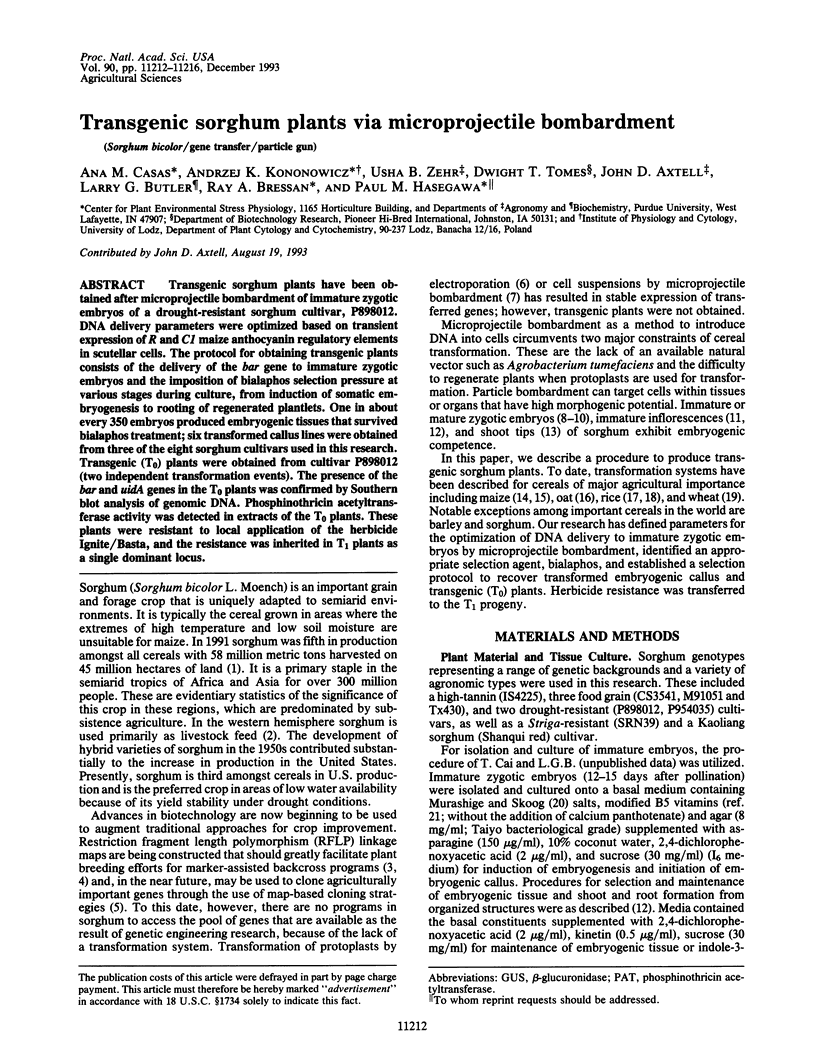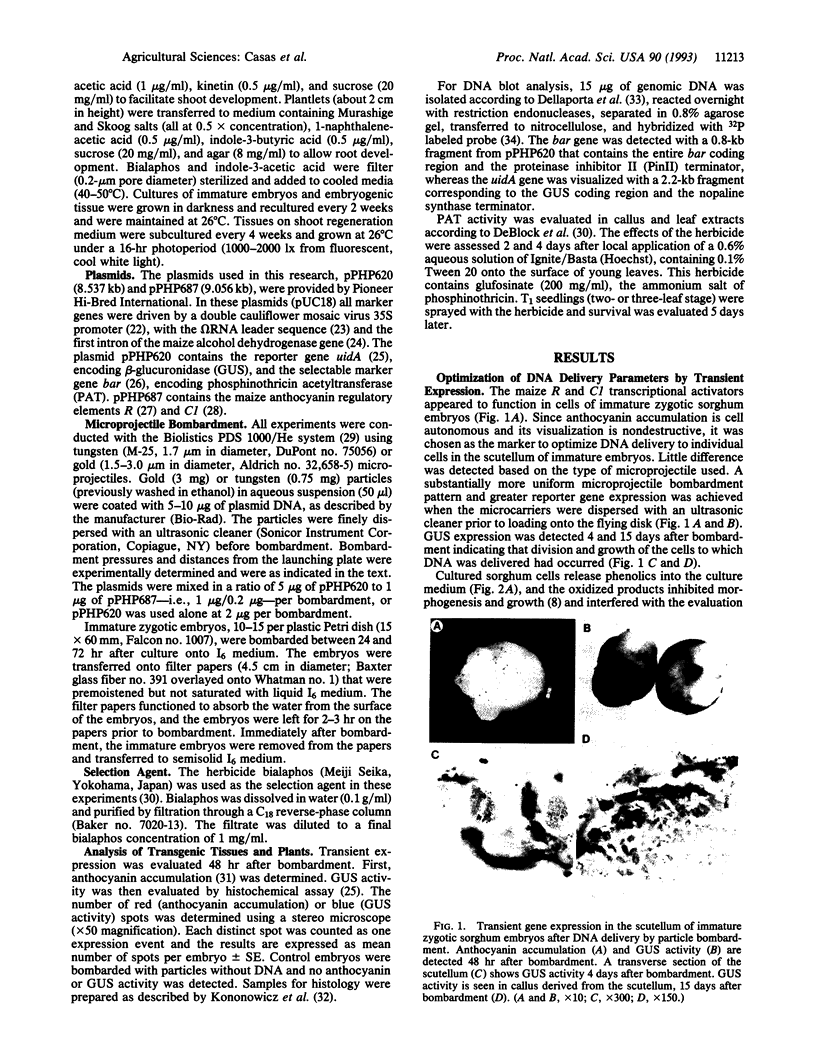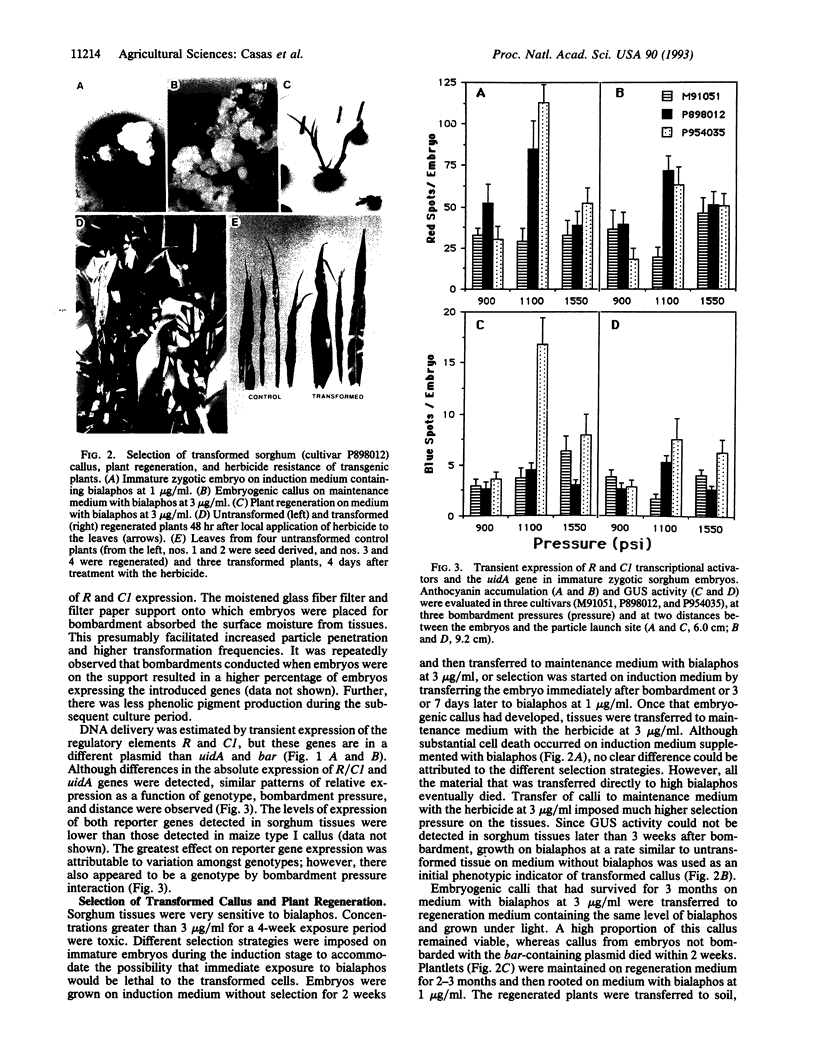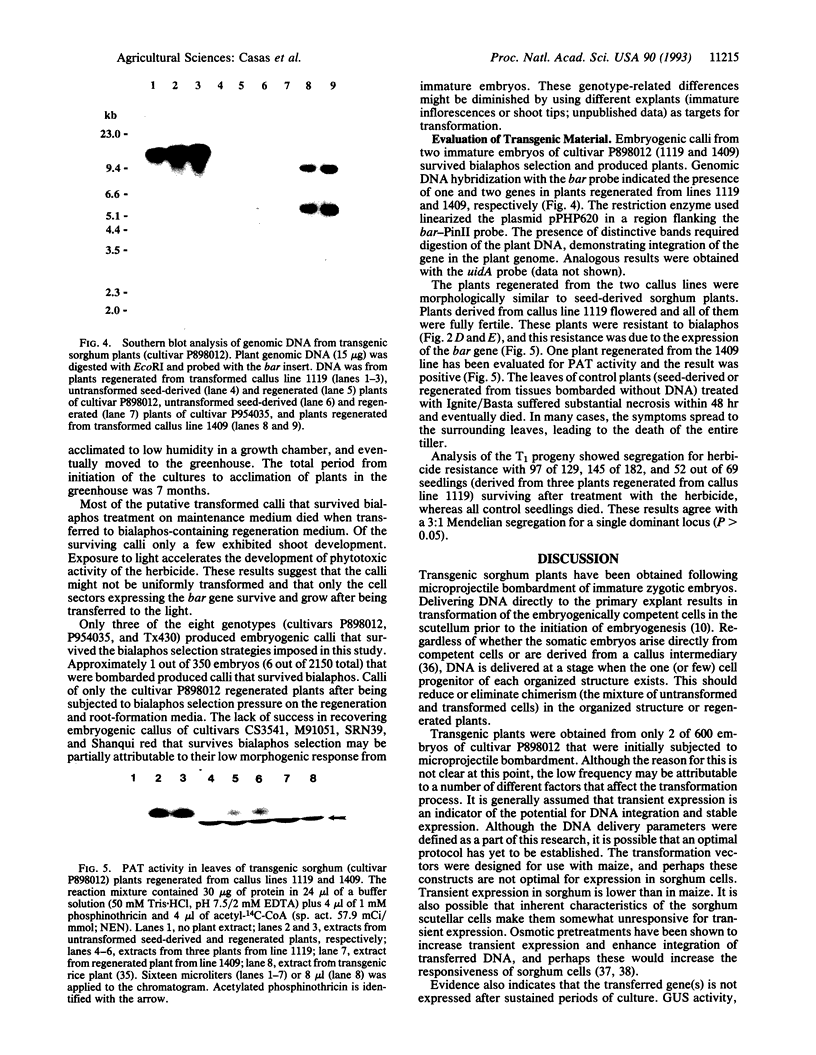Abstract
Transgenic sorghum plants have been obtained after microprojectile bombardment of immature zygotic embryos of a drought-resistant sorghum cultivar, P898012. DNA delivery parameters were optimized based on transient expression of R and C1 maize anthocyanin regulatory elements in scutellar cells. The protocol for obtaining transgenic plants consists of the delivery of the bar gene to immature zygotic embryos and the imposition of bialaphos selection pressure at various stages during culture, from induction of somatic embryogenesis to rooting of regenerated plantlets. One in about every 350 embryos produced embryogenic tissues that survived bialaphos treatment; six transformed callus lines were obtained from three of the eight sorghum cultivars used in this research. Transgenic (T0) plants were obtained from cultivar P898012 (two independent transformation events). The presence of the bar and uidA genes in the T0 plants was confirmed by Southern blot analysis of genomic DNA. Phosphinothricin acetyltransferase activity was detected in extracts of the T0 plants. These plants were resistant to local application of the herbicide Ignite/Basta, and the resistance was inherited in T1 plants as a single dominant locus.
Full text
PDF




Images in this article
Selected References
These references are in PubMed. This may not be the complete list of references from this article.
- Block M. D., Botterman J., Vandewiele M., Dockx J., Thoen C., Gosselé V., Movva N. R., Thompson C., Montagu M. V., Leemans J. Engineering herbicide resistance in plants by expression of a detoxifying enzyme. EMBO J. 1987 Sep;6(9):2513–2518. doi: 10.1002/j.1460-2075.1987.tb02537.x. [DOI] [PMC free article] [PubMed] [Google Scholar]
- Bochardt A., Hodal L., Palmgren G., Mattsson O., Okkels F. T. DNA methylation is involved in maintenance of an unusual expression pattern of an introduced gene. Plant Physiol. 1992 Jun;99(2):409–414. doi: 10.1104/pp.99.2.409. [DOI] [PMC free article] [PubMed] [Google Scholar]
- Callis J., Fromm M., Walbot V. Introns increase gene expression in cultured maize cells. Genes Dev. 1987 Dec;1(10):1183–1200. doi: 10.1101/gad.1.10.1183. [DOI] [PubMed] [Google Scholar]
- Fromm M. E., Morrish F., Armstrong C., Williams R., Thomas J., Klein T. M. Inheritance and expression of chimeric genes in the progeny of transgenic maize plants. Biotechnology (N Y) 1990 Sep;8(9):833–839. doi: 10.1038/nbt0990-833. [DOI] [PubMed] [Google Scholar]
- Gallie D. R., Sleat D. E., Watts J. W., Turner P. C., Wilson T. M. The 5'-leader sequence of tobacco mosaic virus RNA enhances the expression of foreign gene transcripts in vitro and in vivo. Nucleic Acids Res. 1987 Apr 24;15(8):3257–3273. doi: 10.1093/nar/15.8.3257. [DOI] [PMC free article] [PubMed] [Google Scholar]
- Gordon-Kamm W. J., Spencer T. M., Mangano M. L., Adams T. R., Daines R. J., Start W. G., O'Brien J. V., Chambers S. A., Adams W. R., Jr, Willetts N. G. Transformation of Maize Cells and Regeneration of Fertile Transgenic Plants. Plant Cell. 1990 Jul;2(7):603–618. doi: 10.1105/tpc.2.7.603. [DOI] [PMC free article] [PubMed] [Google Scholar]
- Jefferson R. A., Kavanagh T. A., Bevan M. W. GUS fusions: beta-glucuronidase as a sensitive and versatile gene fusion marker in higher plants. EMBO J. 1987 Dec 20;6(13):3901–3907. doi: 10.1002/j.1460-2075.1987.tb02730.x. [DOI] [PMC free article] [PubMed] [Google Scholar]
- Kay R., Chan A., Daly M., McPherson J. Duplication of CaMV 35S Promoter Sequences Creates a Strong Enhancer for Plant Genes. Science. 1987 Jun 5;236(4806):1299–1302. doi: 10.1126/science.236.4806.1299. [DOI] [PubMed] [Google Scholar]
- Kononowicz A. K., Nelson D. E., Singh N. K., Hasegawa P. M., Bressan R. A. Regulation of the Osmotin Gene Promoter. Plant Cell. 1992 May;4(5):513–524. doi: 10.1105/tpc.4.5.513. [DOI] [PMC free article] [PubMed] [Google Scholar]
- Ludwig S. R., Bowen B., Beach L., Wessler S. R. A regulatory gene as a novel visible marker for maize transformation. Science. 1990 Jan 26;247(4941):449–450. doi: 10.1126/science.247.4941.449. [DOI] [PubMed] [Google Scholar]
- Ludwig S. R., Habera L. F., Dellaporta S. L., Wessler S. R. Lc, a member of the maize R gene family responsible for tissue-specific anthocyanin production, encodes a protein similar to transcriptional activators and contains the myc-homology region. Proc Natl Acad Sci U S A. 1989 Sep;86(18):7092–7096. doi: 10.1073/pnas.86.18.7092. [DOI] [PMC free article] [PubMed] [Google Scholar]
- Paz-Ares J., Ghosal D., Wienand U., Peterson P. A., Saedler H. The regulatory c1 locus of Zea mays encodes a protein with homology to myb proto-oncogene products and with structural similarities to transcriptional activators. EMBO J. 1987 Dec 1;6(12):3553–3558. doi: 10.1002/j.1460-2075.1987.tb02684.x. [DOI] [PMC free article] [PubMed] [Google Scholar]
- Rathore K. S., Chowdhury V. K., Hodges T. K. Use of bar as a selectable marker gene and for the production of herbicide-resistant rice plants from protoplasts. Plant Mol Biol. 1993 Mar;21(5):871–884. doi: 10.1007/BF00027118. [DOI] [PubMed] [Google Scholar]
- Thompson C. J., Movva N. R., Tizard R., Crameri R., Davies J. E., Lauwereys M., Botterman J. Characterization of the herbicide-resistance gene bar from Streptomyces hygroscopicus. EMBO J. 1987 Sep;6(9):2519–2523. doi: 10.1002/j.1460-2075.1987.tb02538.x. [DOI] [PMC free article] [PubMed] [Google Scholar]
- Whitkus R., Doebley J., Lee M. Comparative genome mapping of Sorghum and maize. Genetics. 1992 Dec;132(4):1119–1130. doi: 10.1093/genetics/132.4.1119. [DOI] [PMC free article] [PubMed] [Google Scholar]






